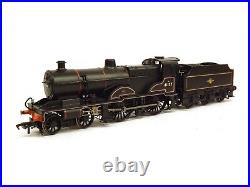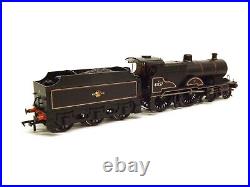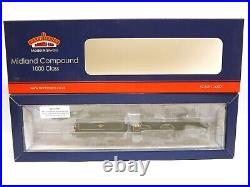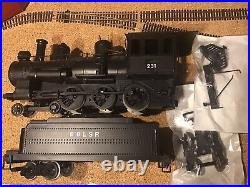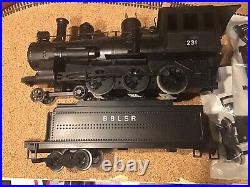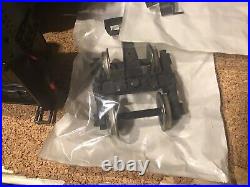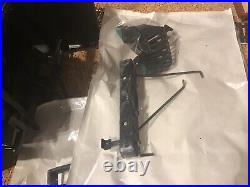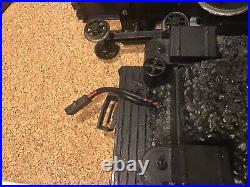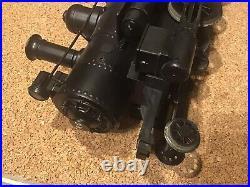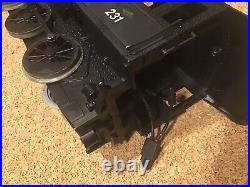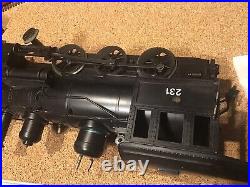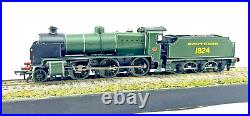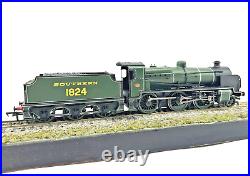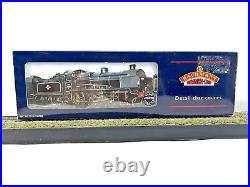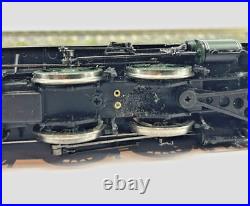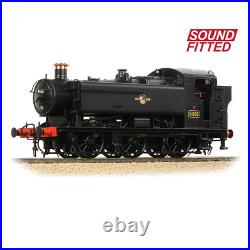
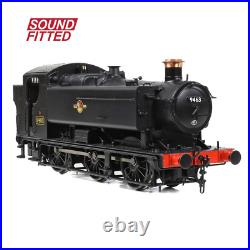
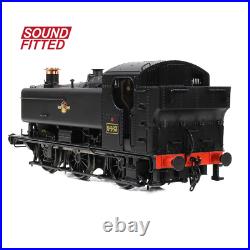
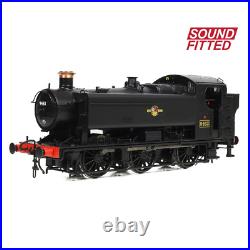
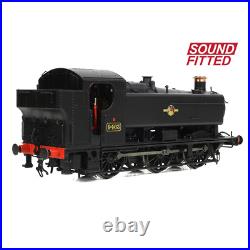
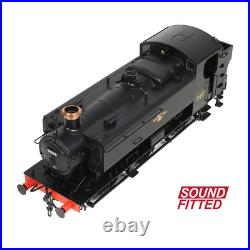
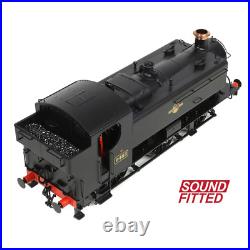
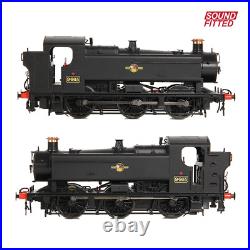
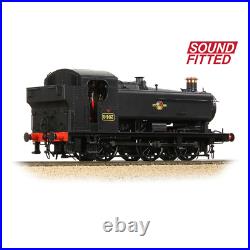

Bachmann 35-027ASF – 94XX Class Pannier Tank 9463 BR Black Late Crest SOUND FITTED. A quintessential part of the GWR for many decades, the Pannier Tank design was developed and refined before the 94xx, the final design of GWR tank engine, was produced. Take a closer look at the Branchline model and you will see a wealth of detail, from the separately fitted pipe runs that extend all the way from the front bufferbeam to the back, to the modelling of the inside motion which is authentically decorated too. There are handrails aplenty – all separately fitted of course – whilst the metal lamp brackets, separate smokebox door dart and whilst with guard and supply pipes all catch the eye. Sprung buffers are fitted at the front and rear along with a copper cap to the chimney. Look inside the cab and a full complement of controls and dials is present, all decorated accordingly, which is only added to by the firebox lighting system which adds a further dimension of realism to every model. Technically the 94xx shines as well, with a Next18 DCC decoder socket paired with an integrated speaker making SOUND FITTED models an option if you wish to enjoy sound effects when operating your model railway. The powerful coreless motor drives the rear axle and electrical collection comes from all wheels, whilst each axle is fitted with a pair of separate metal bearings. MODEL FEATURES: Bachmann Branchline OO Scale Era 5 Pristine BR Black (Late Crest) livery Running No. 9463 Accessory Pack NEM Coupling Pockets Sprung Buffers Powerful Coreless Motor Firebox Glow (on analogue) / Firebox Glow & Flicker (on DCC) Speaker Fitted SOUND FITTED – Fitted with a ESU Loksound V5DCC Sound Decoder – See below for the function list Length 138mm SOUNDS F1 – Sound On / Sound Off F2 – Brake (Non-Latching) F3 – Cylinder Drain Cocks F4 – Whistle, High Tone (Playable) F5 – Normal Load / Heavy Load F6 (STATIONARY) – Firebox Door Open (red firebox light flickers) F6 (MOVING) – Firebox Door Open (red firebox light flickers and yellow light pulses in time with the exhaust) F7 – Injectors F8 – Whistle, Low Tone (Playable) F9 – Flange Squeal F10 – Shovelling Coal (F6 must be On to activate this function) F11 – Blower (with F6 On and the locomotive stopped the red and yellow firebox lights will also flicker) F12 – Hand Brake (locomotive will not move with the Hand Brake applied) F13 – Water Tank Filling F14 – Coupling/un-Coupling Clank F15 – Safety Valve F16 – Guard’s Whistle & Driver’s Response Toot F17 – Coasting F18 – Rail Join Clatter (Speed Variable) F19 – Shunt Mode (reduces speed) F20 – Acceleration/Deceleration inertia off F21 – Volume Control (LATCH = Volume On/Off) or (TRIGGER = cycles 6 Volume Levels) Analogue Users: Normal-load running sounds, acceleration steam chuff sounds and any other automatic and randomised sounds can be enjoyed when using this model on analogue control (DC) straight from the box – these sounds will play automatically when power is applied! GWR 94XX CLASS HISTORY The distinctive 94XX Class 0-6-0 Pannier Tank was the last steam locomotive built by the Great Western Railway (GWR); the first ten being turned out in the company’s Middle Chrome Green by Swindon Works before nationalisation. Effectively a tank version of the Collett’2251′ tender engine, the remaining 200 locomotives were built for BR between 1949 and 1956 by outside contractors Robert Stephenson, Yorkshire Engine Co. Outshopped in unlined black livery, there were minor detail differences between the locomotives built by different contractors. All were capable of providing steam-heating for coaching stock. The design of the Class was unusual in that they were one of the few Pannier Tank designs with tapered boilers. Superheating was fitted to Nos. With the onset of modernisation and the introduction of an ever increasing number of diesels, the working life of the Class was very short and of the 210 built, just 78 were still in use in January 1964, withdrawals having commenced in 1959. By the end of June 1965, the last members of the Class were withdrawn with some examples being cut up when they were barely 5 years old. 9400 and 9466 survive in preservation. Technically the 94xx shines as well, with a Next18 DCC decoder socket paired with an integrated speaker making. Models an option if you wish to enjoy sound effects when operating your model railway. Bachmann Branchline OO Scale. Pristine BR Black (Late Crest) livery. Firebox Glow (on analogue) / Firebox Glow & Flicker (on DCC). Fitted with a ESU Loksound V5DCC Sound Decoder – See below for the function list. F1 – Sound On / Sound Off. F2 – Brake (Non-Latching). F3 – Cylinder Drain Cocks. F4 – Whistle, High Tone (Playable). F5 – Normal Load / Heavy Load. F6 (STATIONARY) – Firebox Door Open (red firebox light flickers). F6 (MOVING) – Firebox Door Open (red firebox light flickers and yellow light pulses in time with the exhaust). F8 – Whistle, Low Tone (Playable). F9 – Flange Squeal. F10 – Shovelling Coal (F6 must be On to activate this function). F11 – Blower (with F6 On and the locomotive stopped the red and yellow firebox lights will also flicker). F12 – Hand Brake (locomotive will not move with the Hand Brake applied). F13 – Water Tank Filling. F14 – Coupling/un-Coupling Clank. F16 – Guard’s Whistle & Driver’s Response Toot. F18 – Rail Join Clatter (Speed Variable). F19 – Shunt Mode (reduces speed). F20 – Acceleration/Deceleration inertia off. F21 – Volume Control (LATCH = Volume On/Off) or (TRIGGER = cycles 6 Volume Levels). Analogue Users: Normal-load running sounds, acceleration steam chuff sounds and any other automatic and randomised sounds can be enjoyed when using this model on analogue control (DC) straight from the box – these sounds will play automatically when power is applied! GWR 94XX CLASS HISTORY. The distinctive 94XX Class 0-6-0 Pannier Tank was the last steam locomotive built by the Great Western Railway (GWR); the first ten being turned out in the company’s Middle Chrome Green by Swindon Works before nationalisation. Sorry, our items are NOT available for pick-up. No additional information at this time. You might also like. New – Hornby BR 61ft6in Corridor 1st Class Sleeper Coach – R4264B – OO Gauge. Hornby R4797 – BR Maunsell Corridor 1st Class No. Oxford Diecast 43LAN188021 – Land Rover Series 1 88 Hard Top RAF. Hornby R636 – Double Track Level Crossing.

